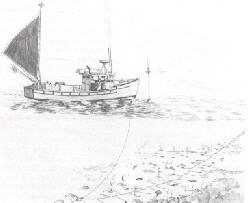|
Longlining is a type of commercial fishing, in use since
the 19th Century.
It is classified as a passive fishing technique, making use
of lines with baited hooks, and is used to catch a number
of fish species including, tuna, shark, swordfish and cod.
A longline consists of a main line to which many
branchlines, or snoods, are attached.
Each snood has a baited hook at its end.
Depending on the type of longline, buoys and weights
are attached to ensure that the longline is at its required
depth.
The number of hooks and lines depends on the size of
vessel, the degree of mechanisation and the size of the
crew.
The vessels used for longlining can range from small
open boats, using manually operated longlines, to large
ocean-going vessels, which are highly mechanized
and specialised and usually engage in single species
fisheries.
The main characteristics of a longline vessel that distinguish it from other fishing vessels are the rail roller, the longline hauler and in particular, the setting chute on traditional longline vessels, or the baiting and gear handling system on mechanised longliners.
The wheelhouse can be situated aft or forward, but on larger vessels the bridge is generally placed aft.
In typical arrangements the gear is hauled from the bow or from the side with a mechanical or hydraulic line hauler and the lines are set over the stern.
Small-scale longliners may haul by hand into baskets or tubs, or by using a hand cranked line drum.
On larger vessels, automatic or semi-automatic systems are installed to bait the hooks and to shoot and haul the lines.
Line storage on larger vessels normally incorporates a line drum, as the lines may be as long as100 km.
In general, such systems consist of rail roller, dehooker and hook cleaner, line hauler, hook separator, storage rack or drum.
Longlines can be used on the seabed, in midwater or just below the surface.
The length of longlines can range from a few hundred metres in coastal fisheries, to more than 100 km in large-scale mechanized fisheries, to which thousands of hooks can be attached.
|




